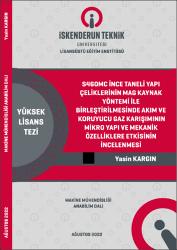| dc.contributor.advisor | Kanca, Erdoğan | |
| dc.contributor.author | Kargın, Yasin | |
| dc.date.accessioned | 2023-12-26T07:23:51Z | |
| dc.date.available | 2023-12-26T07:23:51Z | |
| dc.date.issued | 2022 | en_US |
| dc.identifier.citation | Kargın, Y. (2022). S460MC ince taneli yapı çeliklerinin MAG kaynak yöntemi ile birleştirilmesinde akım ve koruyucu gaz karışımının mikro yapı ve mekanik özelliklere etkisinin incelenmesi. (Yüksek Lisans Tezi). İskenderun Teknik Üniversitesi / Lisansüstü Eğitim Enstitüsü / Makine Mühendisliği Ana Bilim Dalı, Hatay. | en_US |
| dc.identifier.uri | https://hdl.handle.net/20.500.12508/2804 | |
| dc.description.abstract | Bu çalışmada yüksek mukavemetli ince taneli bir çelik olan S460MC çelik plakalar iki farklı
koruyucu gaz kompozisyonu ve iki farklı kaynak akımı değerlerinde, kaynak hızı sabit tutulup
MAG (Metal Aktif Gaz) kaynak yöntemiyle alın-alına kaynak edilmiştir. Kaynak işleminde
kullanılan akım değerleri 140 Amper(A) ve 210 Amperdir. Kullanılan gaz karışımları ise %82
Ar + %18 CO2 ve %92 Ar + %8 CO2 olarak seçimiştir.140 Amper akım değerinde iki gaz
karışımı ile de ayrı ayrı kaynak işlemi yapılmış olup 210 Amper akım değerinde de yine bu iki
gaz karışımı ile ayrı ayrı kaynak yapılmıştır. Bu kaynak işlemleri esnasında kaynak hızı ve diğer
parametreler sabit tutulmuş ve kaynağın kök kısmında sarkma veya kötü bir form oluşmaması
amacıyla seramik altlık kullanılmıştır. Kaynak sonrasında numunelere ilk olarak görsel muayene
ve sonrasında çekme testi, eğme testi, sertlik testi ve makro-mikro analizler uygulanmıştır.
Böylece S460M çeliğinin kaynaklanmasında hem kaynak akımındaki değişimin hem de karışım
gazı olarak Argon gazı ile (Ar) beraber kullanılan CO2 gazı oranındaki değişimin mikro yapı ve
mekanik özelliklere etkisi incelenmiştir.
Yapılan testler sonucunda görsel muayene ve makro yapı incelemelerinde artan CO2 gazı oranı
ve akım ile beraber daha geniş bir kaynak metali (KM) görülmüştür. Mikro yap incelemelerinde
ısıdan etkilenmiş bölge (IEB) CO2 oranının ve akım değerinin artması ile tane irileşmesi
görülmüş ayrıca perlit(P) ve ferrit(F) fazından oluşan yapıda martensit(M) oluşumu da
gözlemlenmiştir. Sertlik ölçüm sonuçlarına bakıldığında akım ve CO2 oranının artması ile
beraber ısı girdisinin artması ve daha yavaş soğuma nedeniyle IEB ve KM bölgelerinde sertlik
değerlerinde düşme görülmüştür. Çekme testi sonuçlarına bakıldığında ise kaynak akımındaki
ve CO2 miktarındaki artış akma ve çekme dayanımlarını düşürmüştür. Son olarak eğme testleri
sonucuna göre kaynaklı birleştirmelerde herhangi bir çatlak, yırtılma, mikro gözenek veya
kalıntıya rastlanmamıştır. 180º hem kep hem de kök eğme testlerinin sorunsuz bir şekilde
tamamlandığı görülmüştür. | en_US |
| dc.description.abstract | In this study, S460M steel plates, a high strength fine grained steel, were welded face-toface
with two different shielding gas compositions and two different welding current values,
keeping the welding speed constant, with MAG (Metal Active Gas) welding method. The
current values used in the welding process are 140 Amperes (A) and 210 Amperes. The gas
mixtures used were 82% Ar + 18% CO2 and 92% Ar + 8% CO2. Welding was done separately
with two gas mixtures at 140 Ampere current value, and also with these two gas mixtures at
210 Ampere current value.During these welding processes, the welding speed and other
parameters were kept constant and a ceramic backing plate was used in order to prevent
sagging or a bad form in the root of the weld. After welding, first visual inspection and then
tensile test, bending test, hardness test and macro-micro analysis were applied to the
samples. Thus, the effect of both the change in welding current and the change in the ratio
of CO2 gas used together with Argon gas (Ar) gas as the mixing gas, on the microstructure
and mechanical properties of S460M steel were investigated.As a result of the tests
performed, a wider weld metal (WM) was observed with the increased CO2 gas rate and flow
in visual inspection and macro structure examinations. In the microstructure investigations,
grain coarsening was observed with the increase of the CO2 ratio and the current value in the
heat-affected zone (HAZ). When the hardness measurement results are examined, it was
observed that the hardness values decreased in the HAZ and WM regions due to the increase
in the heat input and slower cooling with the increase in the current and CO2 ratio. When the
tensile test results were examined, ıt was observed that increase in the welding current and
the amount of CO2 decreased the yield and tensile strengths. Finally, according to the results
of the bending tests, no cracks, tears, micropores or residues were found in the welded joints.
It has been observed that both the cap and root bending tests at 180º were completed without
any problems. | en_US |
| dc.language.iso | tur | en_US |
| dc.publisher | İskenderun Teknik Üniversitesi / Lisansüstü Eğitim Enstitüsü / Makine Mühendisliği Ana Bilim Dalı | en_US |
| dc.rights | info:eu-repo/semantics/openAccess | en_US |
| dc.subject | Kaynak teknolojisi | en_US |
| dc.subject | MAG | en_US |
| dc.subject | S460M | en_US |
| dc.subject | İnce taneli çelik | en_US |
| dc.subject | Mekanik özellikler | en_US |
| dc.subject | Welding technologies | en_US |
| dc.subject | Fine-grain structural steel | en_US |
| dc.subject | Mechanical properties | en_US |
| dc.title | S460MC ince taneli yapı çeliklerinin MAG kaynak yöntemi ile birleştirilmesinde akım ve koruyucu gaz karışımının mikro yapı ve mekanik özelliklere etkisinin incelenmesi | en_US |
| dc.title.alternative | Investigation of the effect of curent and protective gas mixture on microstructural and mechanical properties in joining S460MC fine grain structural steels with MAG welding method | en_US |
| dc.type | masterThesis | en_US |
| dc.contributor.department | Mühendislik ve Doğa Bilimleri Fakültesi | en_US |
| dc.identifier.startpage | IV | en_US |
| dc.identifier.endpage | 59 | en_US |
| dc.relation.publicationcategory | Tez | en_US |
| dc.contributor.isteauthor | Kanca, Erdoğan | |
| dc.relation.index | İndeks Bilgisi Yok | en_US |
















